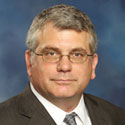The National Archives at San Francisco hosted a public Researcher Forum on Monday, January 28, 2013, at 4:00 p.m., with NARA Research Services Executive Bill Mayer from College Park, Maryland. Mayer oversees fifteen facilities of the National Archives nationwide, but this was his first visit to our regional facility in San Bruno.
The NARA forum was designed to gather feedback from researchers who visit the San Francisco facility on a regular basis. He came to answer questions and discuss issues related to the National Archives as a whole as well as to the San Francisco archive specifically.
Lavinia Schwarz and Judy Bodycote-Thomas represented the California Genealogical Society. Lavinia sent this report:
Judy Bodycote-Thomas and I attended the public researcher forum at the National Archives at San Francisco (which is actually in San Bruno) with Bill Mayer who was hired in May of 2012 as Executive of Research Services at NARA.
Mr. Mayer is traveling to meet and talk with researchers and constituents at all fifteen facilities of the National Archives nationwide. The Seattle-based manager of the western NARA facilities was also in attendance as well as the San Bruno staff and a variety of researchers and historians, individual writers including representatives of Angel Island, Chinese genealogists, and others. Judy and I were pleased to represent the CGS. Mr. Mayer began by thanking the staff for its good service and asking for our input on what we would like the future NARA to be.
Black and White vs. Color
He told us of ongoing discussions about color vs. black and white digitizations; whether old microfilm should be recopied; concerns about minimal handling of old documents; space limitation of the various facilities (Cape Canaveral data is now being transferred north). Attendees prefered color – especially for maps and building plans which are often color coded. We pointed out that the earlier black and white microfilming was done when color procedures were not yet available, but to fulfill NARA's goal of preserving documents we preferred the preservation of the original color as opposed to changing original documents to black and white.
One attendee asked if it is possible to digitize a front page with maximum information and indicate that a certain number of pages follow, e.g., an Angel Island file might have a name, date, photo, and say that the person's file consists of 30 more pages. Apparently, this would be quite hard as the information is dispersed throughout the file so creation of the front page would be labor intensive.
Another asked why the photos of Pearl Harbor, which used to be housed at San Bruno, have never been returned after they were borrowed while text documents have? Apparently all these docs were sent to Pearl Harbor at one point with the intention of their being returned for permanent housing at San Bruno, but the photos have been retained in a warehouse in Hawaii which is difficult for researchers to get access to. There was discussion of a trio of possible "owners" of the photos – The USS Arizona group, the US Navy, and the US Park Service. Without agreement among them, the photos have not been copied nor returned. This is an ongoing issue.
Another question was why are copies priced by the linear foot? Some maps, plans, Chinese scrolls, etc. are quite long. However, a flat fee, say $5 for simple text might suffice for other items. Mr. Mayer mentioned discussion of having researchers use NARA flash drives to make their copies, and those digitizations being added to the NARA files as they are made. This might be a way to expand the digitization process organically. We were amendable until he mentioned that we'd have to fill out forms as we made our copies. And there were questions about how labor intensive this would be for the staff each day to add the new digitizations to the database. Clearly NARA is trying to figure out how we can help them.
Mr. Mayer gave us his card and encouraged us to email him with specific suggestions. It was very good we were there.
William A. Mayer was appointed Executive for Research Services for the National Archives and Records Administration in June 2012 when he was the University Librarian at American University in Washington, D.C. Previously, he served as the Associate University Librarian for Information Technology and Technical Services at George Washington University and as an adjunct faculty member for the School of Library and Information Science at Catholic University. Prior to his twenty-year career in academic libraries, Mayer worked in a variety of occupations, including vineyard management, cattle ranching, and residential construction. His interests include ocean ecology, music, and next-generation learning systems. He earned a B.A. in English Literature from the University of Washington and a M.L.S. from Simmons College in Boston.
Copyright © 2013 by Kathryn M. Doyle, California Genealogical Society and Library.









0 comments:
Post a Comment